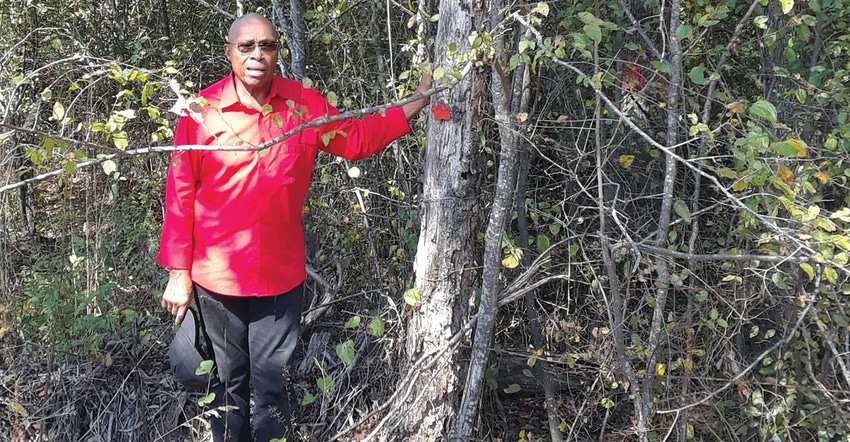June 8, 2020

Landowners should have a copy of a certified property survey map and land description to confirm land boundaries before making any big changes or improvements, Kandi Williams, outreach coordinator for the University of Arkansas at Pine Bluff’s Keeping it in the Family (KIITF) Sustainable Forestry and African-American Land Retention Program, said. Having a land survey on hand allows landowners to understand their property’s boundaries before conducting activities such as harvesting timber, building roads or installing any buildings.
“It is against the law to harvest timber on any property on which the boundaries are not clearly marked,” Joe Friend, UAPB forester, said. “Landowners run the risk of expensive lawsuits if they accidentally cut timber on their neighbor’s property. And they don’t want their neighbors encroaching and damaging their property either.”
Justin Mallett, KIITF Program partner and county forester for the Arkansas Department of Agriculture – Forestry Division, said having a boundary survey protects a landowner’s property from encroachment and helps them avoid costly property disputes.
“A better relationship with neighbors is one benefit of a land survey,” he said. “It is much easier to keep a good relationship with your neighbors than it is to repair a relationship due to a mistake because of lack of planning. A good neighbor can be very beneficial in managing and protecting property.”
Mallett said during boundary surveys, surveyors visit an individual’s property and determine where the land’s boundaries are. They compare the boundaries with those on previous surveys, look for and record previous survey markers and replace missing survey markers. They then record all their findings in a type of map-diagram called a “plat.”
Protect boundary markers
Mallett said landowners can benefit from keeping a few tips in mind during and after the survey process. First and foremost, they should protect boundary markers.
“It is important to clearly mark property corners so they will be easy to find later,” he said. “Surveyors usually drive 1/2-inch rebar markers into the ground so heavy equipment or a cow with an itch won’t disturb it. The markers have a plastic cap with the surveyor’s name and license number. These stakes, however, can be difficult to find — even if you know where they are supposed to be.”
Mallett recommends that landowners place a metal T-post near each marker, while leaving some room to ensure the post does not hit or move the marker. The posts should not replace the markers, as surveyors only reference official survey markers.
“Never move survey markers — even if you wish your corners were located somewhere else,” he said. “Simply moving them will not help you. If you muddy the waters by making distances different from what is referenced, the next surveyor may have to spend more time proving the other corners and recalculating the ones you moved. More time will mean having to spend more money.”
Those who own timberland should ask their surveyor to mark their boundary lines on trees. Some surveyors will flag the trees, and others will mark them with boundary line paint.
“I recommend paying surveyors the extra amount to use boundary paint,” he said. “Depending on paint visibility, a forestry professional, landowner or surveyor will only need to refresh or maintain those lines every five to 10 years.”
Save plats
Mallett said landowners should always remember to save their plats. It is much easier to reference one’s own plat than searching for one online or at the county clerk’s office.
“Many surveyors will charge you for the time spent looking up and reprinting plats,” Mallett said. “Save yourself time and money by keeping your plat in a safe place.”
Mallett said some landowners who want to eventually leave their property to heirs occasionally run into a problem when they add improvements such as houses or buildings to their property. They should always be sure to split their property in such a way as to ensure a building isn’t sitting on two individuals’ properties.
“This may sound crazy, but almost every surveyor who has been in the business a while has come across the issue of a house or other building being partially located on another person’s property,” he said.
Property heirs
Property heirs who inherit land that has not been surveyed will also have trouble managing their land, Mallett reminds.
“I know landowners who can’t harvest their inherited properties yet because they lack a survey,” he said. “That is one more stumbling block for them to be able to manage their property. If you want your heirs to keep property in the family, they have to be able to manage it. Dividing a property up evenly with accesses to utilities and roadways is also helpful to individual heirs.”
In case of questions on getting a land survey, Mallett recommends Arkansas landowners call the Division of Land Surveys at (501) 683-1666, the University of Arkansas Cooperative Extension Service at (501) 671-2000, the U.S. Department of Agriculture Natural Resources Conservation Service (NRCS) at (501) 301-3100, or the Arkansas Forestry Division at (501) 225-1598.
For more information on UAPB’s KIITF Sustainable Forestry and African-American Land Retention Program, contact Williams at (870) 571-9428 or [email protected].
Source: UAPB School of Agriculture, Fisheries and Human Sciences, which is solely responsible for the information provided and is wholly owned by the source. Informa Business Media and all its subsidiaries are not responsible for any of the content contained in this information asset.
About the Author(s)
You May Also Like




